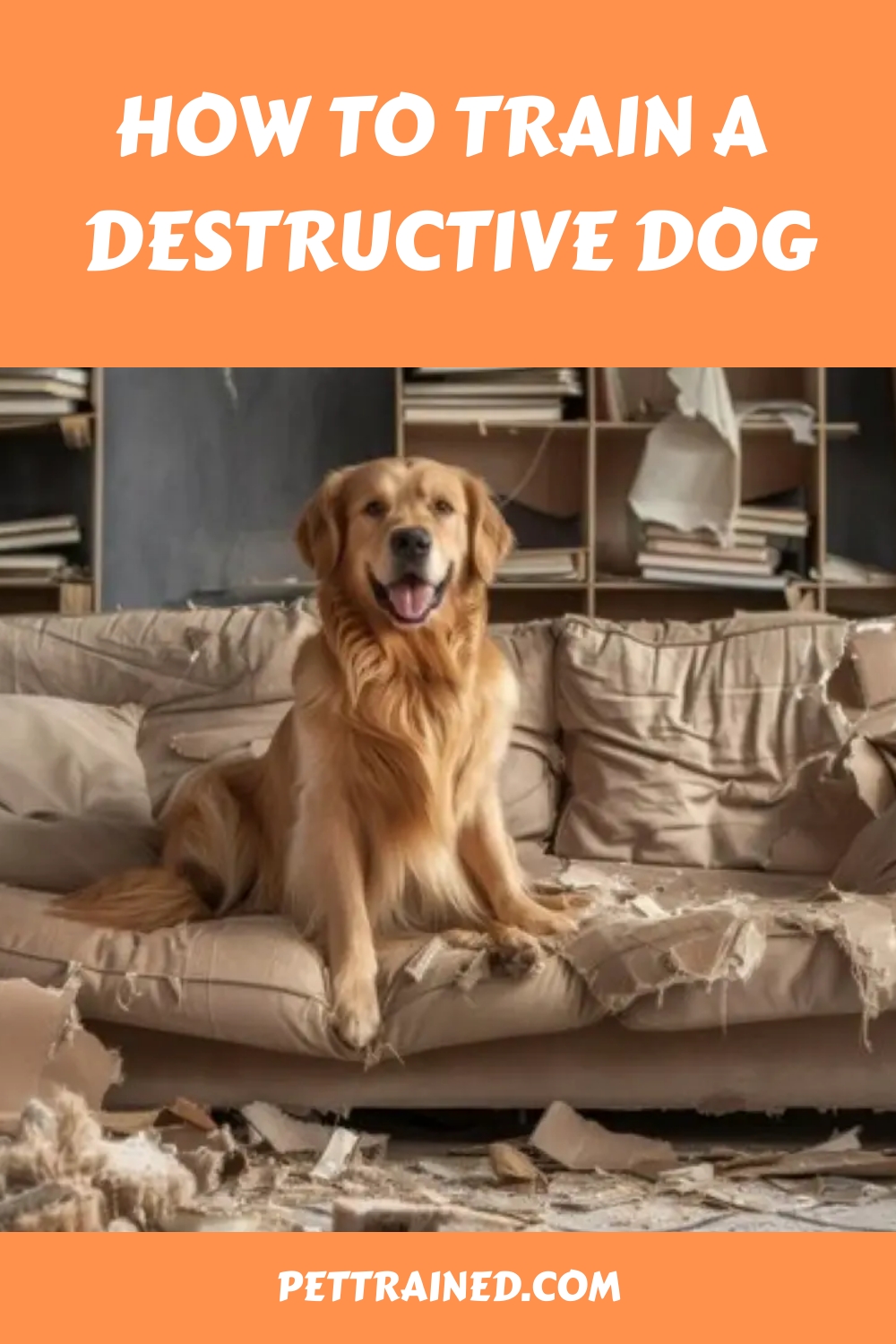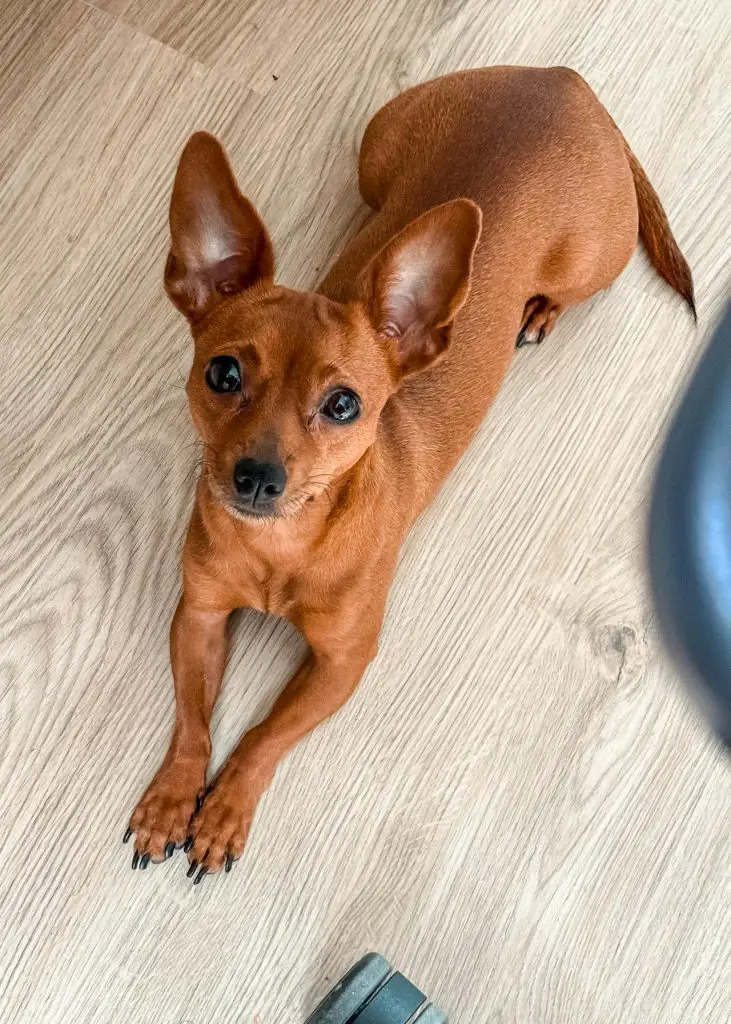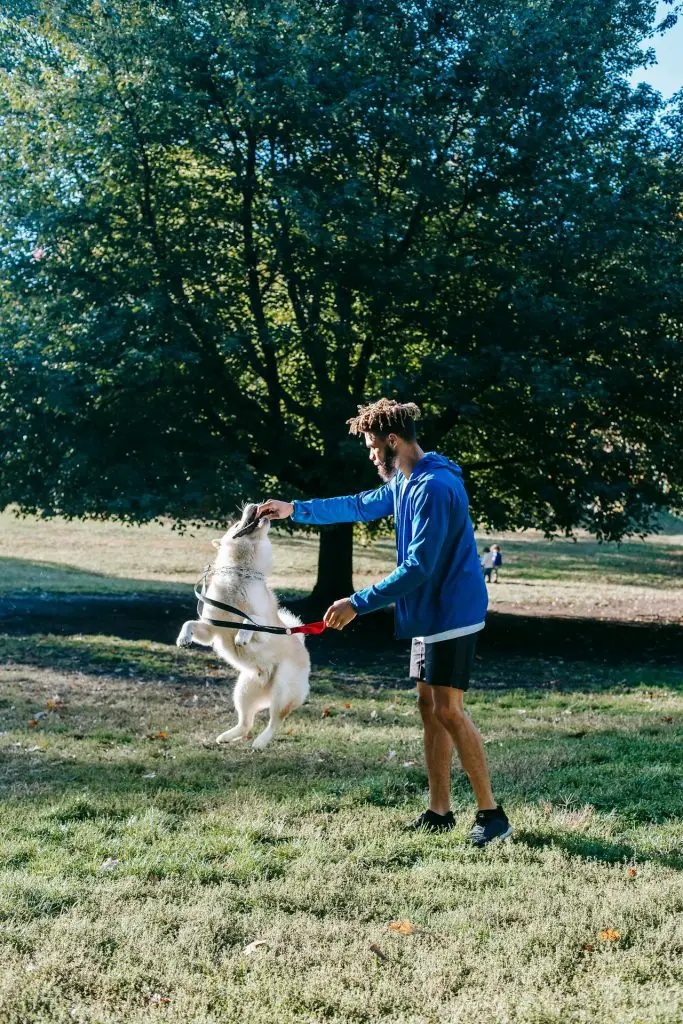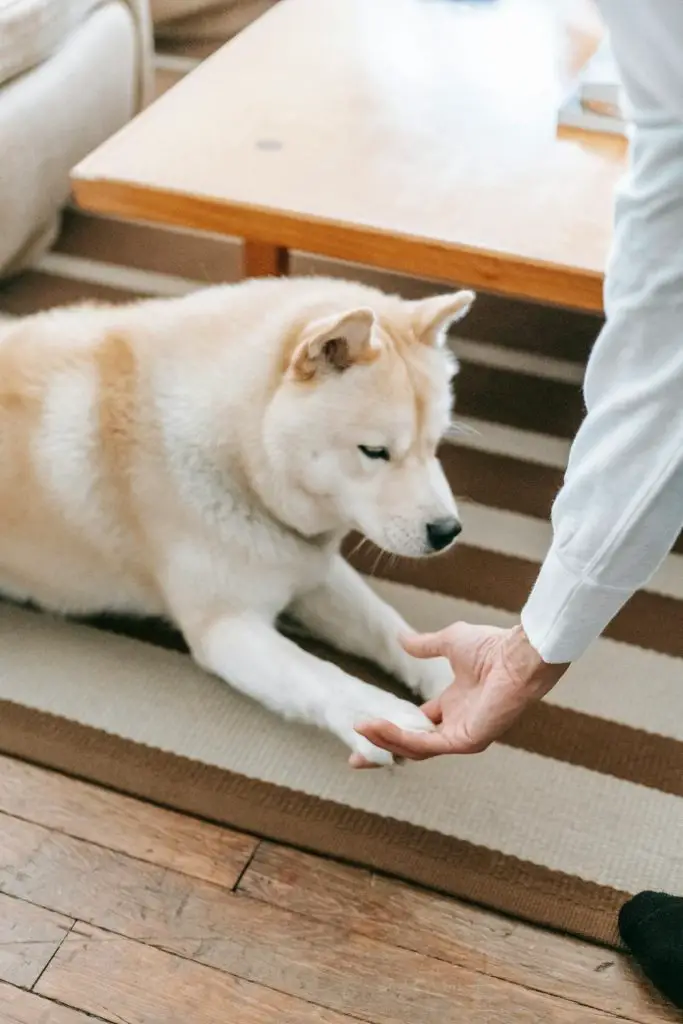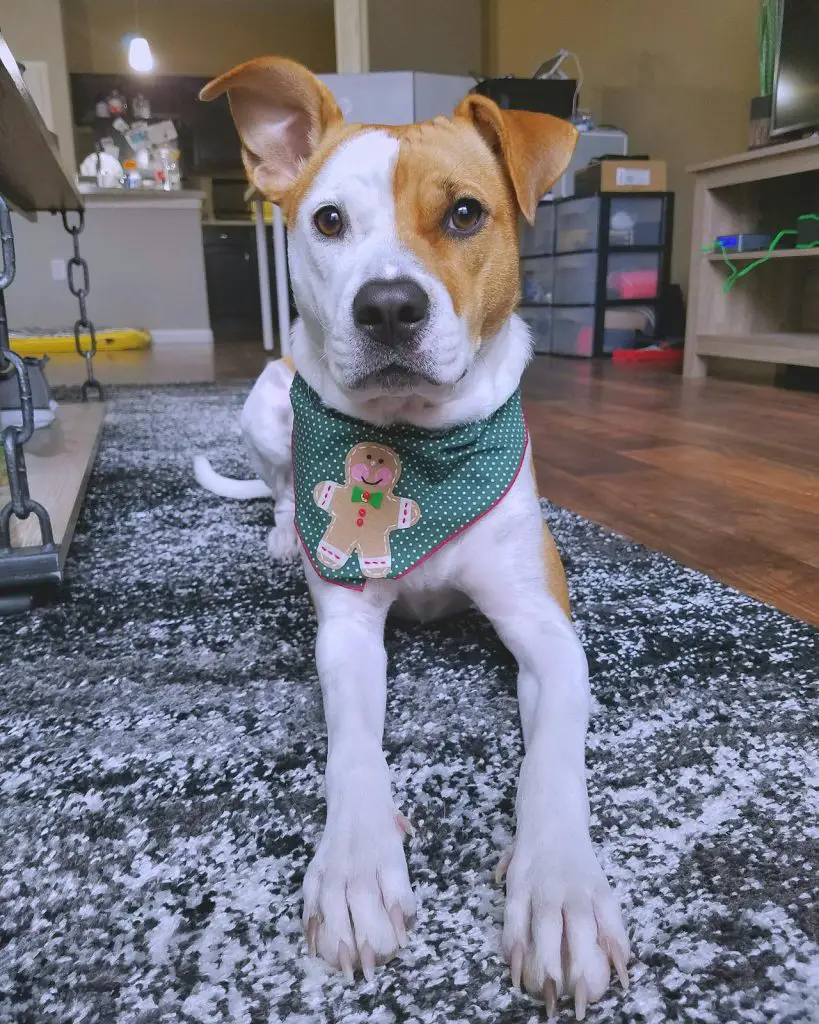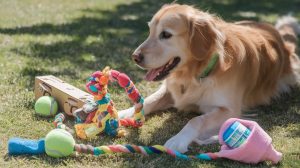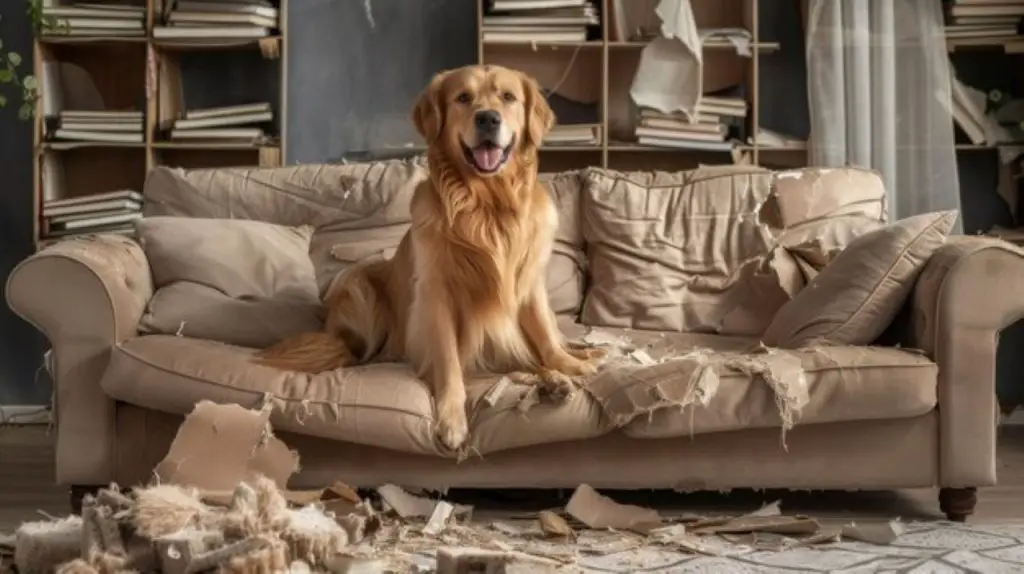
You correct bad behavior and cultivate good habits in equal measure when you train a destructive dog. You need to identify the underlying causes of their behavior, such as separation anxiety or lack of stimulation, and address them directly. By providing regular exercise and mental challenges, you can keep your dog engaged and focused on acceptable activities. But what happens when these efforts aren’t enough, and your dog continues to act out – destroying furniture, shoes, or other household items? That’s where things get tricky, and you’ll need to contemplate alternative strategies to redirect their behavior.
Table of Contents
Key Takeaways

- Identify underlying causes of destructive behavior, such as boredom, stress, or attention-seeking, to develop an effective training plan.
- Provide adequate exercise and mental stimulation through regular walks, playtime, and training to reduce stress and anxiety.
- Use positive reinforcement training techniques, such as clicker training and rewards, to encourage desirable behaviors and discourage destructive ones.
- Create a safe and secure environment by dog-proofing the home, removing hazardous objects, and designating a quiet area for relaxation.
- Establish consistent boundaries and rules, and enforce them positively to teach acceptable behavior and prevent mixed signals.
Identify the Underlying Causes
Destructive behavior in dogs is often a symptom of a deeper issue. To address the problem, you need to identify the underlying causes. Start by examining your dog’s behavioral triggers.
What sets them off? Is it boredom, attention seeking, or stress factors?
You should also consider your dog’s emotional needs. Are they getting enough attention and affection? Establishing a consistent daily routine can help reduce anxiety and minimize destructive behaviors.
This includes setting regular times for feeding, walking, and playtime.
This post contains affiliate links. However all the information provided on this site are my own honest opinions. See more in Disclaimer.
Environmental factors, such as changes in your work schedule or a new pet in the house, can also contribute to destructive behavior. Past experiences, including trauma or abuse, can also play a role.
Socialization issues, such as fear or aggression towards people or other animals, may also be a factor. Additionally, health concerns, such as pain or discomfort, can cause destructive behavior.
Certain breed tendencies may also be a contributing factor.
By understanding the root cause of your dog’s destructive behavior, you can develop an effective plan to address it. Take note of your dog’s boredom levels, as this can be a significant contributor to destructive behavior.
Once you’ve identified the underlying causes, you can start working on a solution.
Provide Adequate Exercise and Stimulation
You’ll need to address your dog’s physical activity needs to prevent destructive behavior caused by excess energy. Regular exercise, such as daily walks and playtime, can help reduce your dog’s stress and anxiety levels.
Long walks and hikes offer both physical exercise and mental stimulation, encouraging exploration and socialization.
Additionally, you’ll want to incorporate mental stimulation techniques, like puzzle toys and obedience training, to challenge your dog’s mind and keep them engaged.
Physical Activity Needs
A dog’s excess energy often manifests as destructive behavior, and providing adequate physical activity is crucial in redirecting this energy into more productive outlets.
You need to assess your dog’s individual energy levels and breed-specific needs to determine the right amount and intensity of physical activity.
Establishing regular playtime routines helps burn off excess energy, reduces boredom, and prevents destructive behavior.
For high-energy breeds, you may need to incorporate more vigorous activities, such as running or agility training.
You should also consider incorporating outdoor adventures, such as hiking or fetch, to provide mental and physical stimulation . These activities challenge your dog physically and mentally, reducing the likelihood of destructive behavior.
Additionally, outdoor activities provide opportunities for socialization, which is essential for a well-adjusted dog.
Guarantee you supervise and participate in playtime routines to reinforce good behavior and strengthen your bond with your dog.
By providing adequate physical activity, you can redirect your dog’s excess energy and reduce destructive behavior. A well-exercised dog is a happier, healthier dog, and a well-behaved companion.
Regular physical activity sets the foundation for successful training and helps you achieve a more balanced relationship with your dog.
Mental Stimulation Techniques
Mental stimulation is an essential component of a dog’s overall well-being, playing a significant role in reducing destructive behavior and promoting a balanced relationship between dog and owner.
You can provide mental stimulation through various activities, such as engaging your dog in puzzle toys filled with treats, scent games that challenge their olfactory system, and interactive play that encourages problem-solving exercises.
Enrolling your dog in training classes is another effective way to mentally stimulate them, as they’ll learn new commands and tasks.
In addition to training classes, socialization opportunities are vital for your dog’s mental development. Canine sports, such as agility and obedience, offer a fun and engaging way to challenge your dog mentally and physically.
Enrichment activities, such as treat dispensers and sensory games, can be used in your daily routine to keep your dog’s mind active.
By incorporating these mental challenges into your dog’s daily routine, you’ll help reduce destructive behavior and promote a well-adjusted, balanced pet.
Regular mental stimulation is key to a happy and healthy dog.
Redirect Destructive Behavior
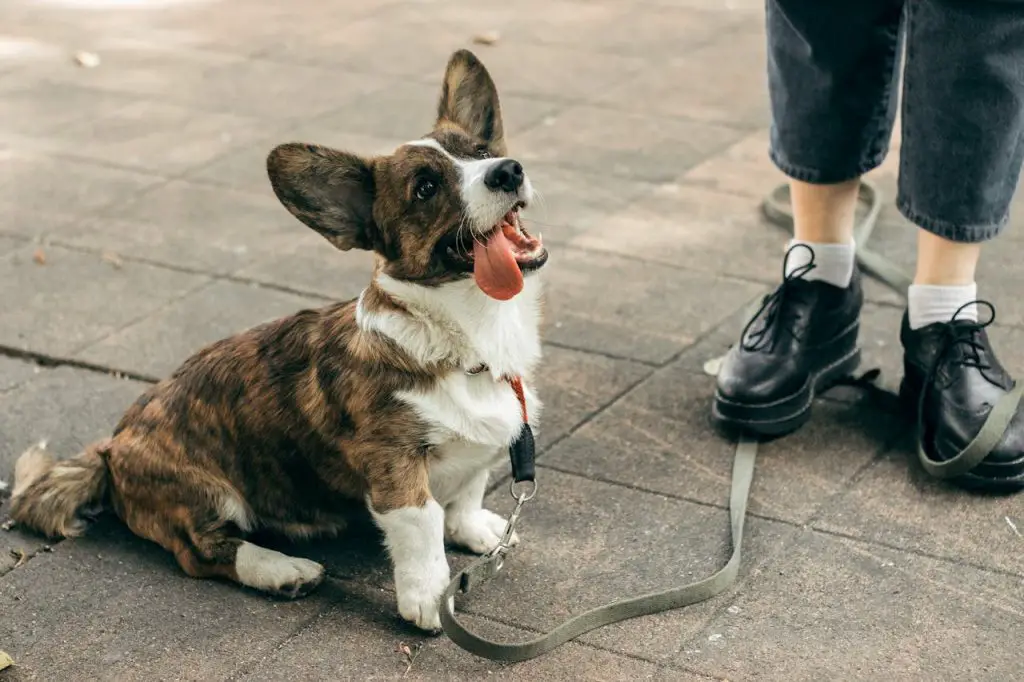
Redirecting destructive behavior in dogs requires a thorough understanding of canine behavior and learning theory.
To redirect your dog’s destructive behavior, you need to identify the underlying causes of the behavior and the situations that trigger it.
Once you’ve identified the triggers, you can develop a plan to manage and redirect the behavior. Basic obedience training is vital for establishing control and laying the groundwork for more advanced behavior modification techniques.
You’ll use distraction techniques to interrupt the destructive behavior and refocus your dog’s attention on a more acceptable activity.
For example, if your dog starts chewing on a shoe, you can distract them with a treat or toy to redirect their attention. Consistency is key when using distraction techniques, so make certain all family members are using the same approach.
Trending in Dogs:
Behavior modification is also essential in redirecting destructive behavior.
By changing your dog’s environment and providing adequate exercise, mental stimulation, and attention, you can reduce the likelihood of destructive behavior occurring.
You’ll also need to teach your dog alternative behaviors to replace the destructive ones, such as chewing on a chew toy instead of furniture.
With patience, consistency, and positive distraction techniques, you can redirect your dog’s destructive behavior and develop more desirable habits.
Use Positive Reinforcement Training
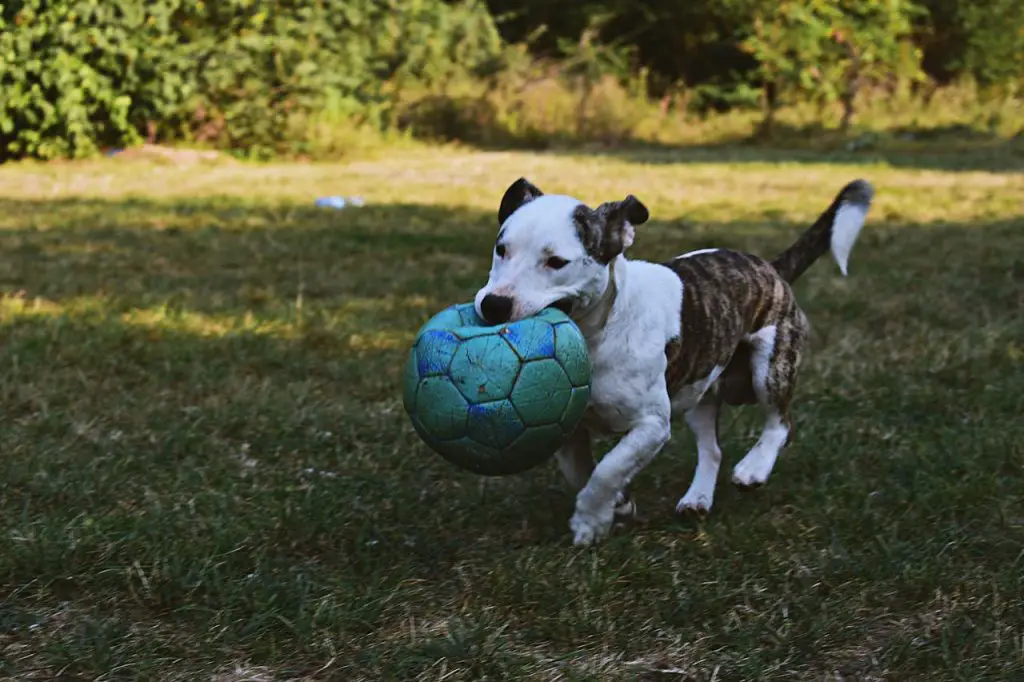
By leveraging the principles of operant conditioning, you can utilize positive reinforcement training to encourage desirable behaviors in your dog.
This approach focuses on associating desired actions with rewards, increasing the likelihood of repetition.
Clicker training is a popular method, where a distinct sound, such as a clicker, marks the exact moment your dog performs the desired behavior, followed by a reward.
Short, frequent sessions are recommended to maintain your dog’s engagement and focus during training.
You can develop a reward system tailored to your dog’s preferences, using treats, praise, affection, or playtime. Consistency is essential, as it helps your dog understand the causal relationship between the behavior and the reward.
By reinforcing desired behaviors, you can redirect your dog’s energy away from destructive actions.
Positive reinforcement training also promotes a stronger bond between you and your dog, built on trust and clear communication.
As you implement positive reinforcement training, remember to set realistic goals and adjust your approach as needed. Be patient, as changing behavior takes time and effort.
Create a Safe and Comfortable Space
You’ll need to create a safe and comfortable space for your dog to relax and reduce destructive behavior.
Dog-proofing the home is vital to prevent accidents and guarantee your pet’s safety. To achieve this, you should designate a quiet area in your home where your dog can retreat when feeling anxious or overwhelmed.
Designate a Quiet Area

A designated quiet area is an essential component of any dog training program, particularly for destructive dogs that require a safe and comfortable space to relax and unwind.
By creating a quiet zone, you’re providing your dog with a haven where they can retreat when feeling overwhelmed or anxious.
This area should be free from distractions, such as loud noises or other pets, and should be easily accessible to your dog at all times.
To designate a quiet area, choose a room or corner of your home that’s quiet and comfortable for your dog.
Add a comfortable bed or mat, and consider incorporating relaxation techniques, such as calming music or a pheromone diffuser, to promote relaxation.
Make sure your dog has access to fresh water and a familiar toy or blanket to provide reassurance.
By providing a quiet area, you’re helping your dog learn to self-soothe and manage stress, which is a vital step in reducing destructive behavior.
Consistency is key, so establish a routine that includes regular quiet time to help your dog feel calm and relaxed.
Remove Hazardous Objects
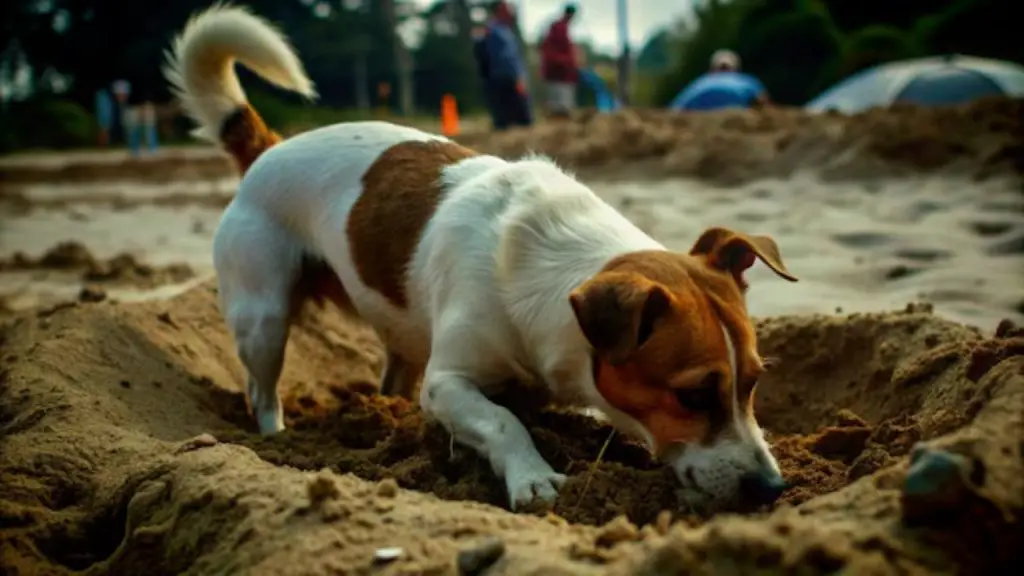
Some household objects can pose a significant threat to your dog’s safety and well-being, particularly if they’re prone to destructive behavior.
You’ll need to take steps to remove hazardous objects from your dog’s environment to prevent harm. This is an essential aspect of dog proofing your home.
Conduct a thorough assessment of your home to identify potential hazards, such as toxic substances, electrical cords, and fragile items. Secure any loose wires, and move toxic substances to high shelves or locked cabinets.
You should also remove any small objects that can be easily swallowed, such as coins, batteries, or jewelry. Replace hazardous items with safe toys and chews to keep your dog occupied and stimulated.
Manage Separation Anxiety Issues

Destructive behavior in dogs is often a symptom of separation anxiety, a common canine behavioral disorder. When you leave your dog alone, they may exhibit distress behaviors such as barking, whining, or destroying objects.
To manage separation anxiety issues, you need to address the underlying dog anxiety.
Start by using calming techniques like gradual departures, which involve leaving your dog alone for short periods and gradually increasing the duration. You can also use comfort items like a familiar toy or blanket to provide reassurance.
Crate training can help create a safe space for your dog, while soothing music can help calm them down. Establishing routine consistency is essential to reducing behavioral triggers.
Separation anxiety affects 20-40% of dogs and can be triggered by changes in routine or moving to a new home. Identify your dog’s triggers and develop a plan to address them.
Provide positive distractions like puzzle toys filled with treats to keep your dog occupied.
Establish Consistent Boundaries and Rules

Consistency is key when teaching your dog what behavior is acceptable and what isn’t. You achieve this through boundary enforcement, establishing clear rules and consequences for misbehavior.
When you enforce rules consistently, your dog learns what’s expected of them and what isn’t allowed.
Consistent cues help dogs understand expectations and the concept of boundaries, making training more effective. This is especially important for certain breeds that may be harder to train.
You must guarantee that all household members are on the same page regarding rule consistency.
If one person lets your dog jump on the furniture, while another doesn’t, it sends mixed signals to your dog, leading to confusion and destructive behavior.
To prevent this, establish clear rules and make sure everyone enforces them consistently.
Boundary enforcement requires patience, persistence, and positive reinforcement. Set clear boundaries and reward your dog for respecting them. When your dog breaks a rule, calmly redirect their behavior and provide a gentle correction.
Avoid punishing or yelling at your dog, as this can create anxiety and exacerbate destructive behavior.
By maintaining rule consistency and enforcing boundaries, you create a stable and predictable environment, helping to curb your dog’s destructive tendencies and fostering a well-behaved companion.
Consistent boundary enforcement trains your dog what’s and isn’t acceptable, reducing destructive behavior.
Frequent Questions and Answers
Of course, you’ll obviously need a PhD in canine chaos to tame your destructive darling – just kidding! Seriously, with consistent training techniques and behavior modification, you can DIY; but hiring a pro can expedite the process.
You shouldn’t use physical punishment to correct your dog’s behavior, as it can lead to fear and aggression. Instead, focus on positive reinforcement and behavior modification techniques to encourage good behavior and discourage destructive habits.
You’re on the cusp of transforming chaos into calm, but the journey’s length is uncertain. With consistent obedience techniques and behavioral modification, you’ll see improvement in weeks, but complete rehabilitation may take months or even years.
You’ll find that certain breeds are more prone to destructive behavior due to their breed characteristics, such as high energy or strong prey drive. Understanding these traits can inform prevention strategies and help you address issues proactively.
You’ll need to review your insurance policies to determine if they include dog liability coverage, which may help pay for damages caused by your destructive dog; some policies may not cover certain breeds or types of damage.
You’ll find that breed characteristics and behavioral genetics do play a role. While any dog can be destructive, certain breeds are predisposed to higher energy levels or specific instincts that may manifest as destructive behavior if not properly managed.
You should start destructive behavior training as early as possible, ideally during the puppy socialization period (3-16 weeks). Early intervention is essential. Don’t wait for problems to develop; proactively teach good habits from the beginning.
Imagine you’re training a telegraph operator, not a dog. You’ll typically see improvements in 2-4 weeks when using consistent behavior modification techniques. Positive reinforcement strategies are key. Stay patient, as progress varies based on the dog’s age and issues.
You should consult your veterinarian about medication types that may help reduce destructive tendencies. However, don’t rely solely on drugs. Combine them with behavioral therapy for the best results in addressing your dog’s destructive behavior.
Yes, professional trainers can specialize in destructive behavior. They’ll perform behavioral assessments and employ targeted training techniques. You’ll find experts who focus solely on curbing your pup’s destructive tendencies.
